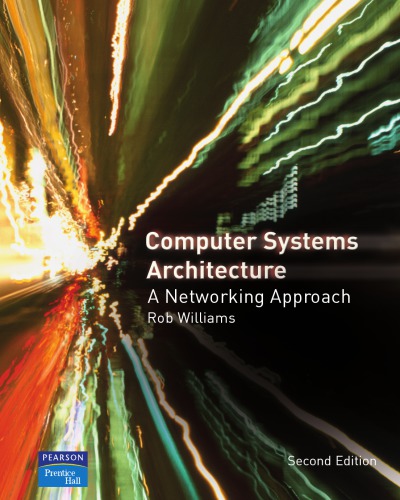

Most ebook files are in PDF format, so you can easily read them using various software such as Foxit Reader or directly on the Google Chrome browser.
Some ebook files are released by publishers in other formats such as .awz, .mobi, .epub, .fb2, etc. You may need to install specific software to read these formats on mobile/PC, such as Calibre.
Please read the tutorial at this link: https://ebookbell.com/faq
We offer FREE conversion to the popular formats you request; however, this may take some time. Therefore, right after payment, please email us, and we will try to provide the service as quickly as possible.
For some exceptional file formats or broken links (if any), please refrain from opening any disputes. Instead, email us first, and we will try to assist within a maximum of 6 hours.
EbookBell Team

5.0
88 reviews 
ISBN 10: 0321340795
ISBN 13: 978-0321340795
Author: Rob Williams
The first Computer Architecture text to recognize that computers are now predinantly used in a networking environment, fully updated to include new technologies and with an all new chapter on Distributed Computing.
Part 1 – Basic Functions and Facilities of a Computer
Introduction: The Hardware–Software Interface
Computer Systems – The Importance of Networking
Hardware and Software – Mutual Dependence
Programming Your Way into Hardware – VHDL, a Language for Electronic Engineers
Voice, Image and Data – Technological Convergence
Windowing Interfaces – WIMPs
The Global Internet – Connecting All the Networks
Using the PC – A Case Study; More Reasons to Study CSA
The von Neumann Inheritance
Stored Program Control – General-Purpose Machines
Instruction Codes – Machine Action Repertoire
Linking – Bringing It All Together
Interpreters – Executing High-Level Commands
Code Sharing and Reuse – Let’s Not Write It All Again!
Data Codes – Numeric and Character
The Operating System – Unix and Windows
Client–Server Computing – The Way of the Net
Reconfigurable Hardware – An Alternative to Fetch–Execute
Functional Units and the Fetch–Execute Cycle
The Naming of Parts – CPU, Memory, IO Units
The CPU Fetch–Execute Cycle – High-Speed Tedium
System Bus – Synchronous or Asynchronous?
System Clock – Instruction Cycle Timing
Pre-Fetching – Early Efforts to Speed Things Up
Memory Length – Address Width
Endian-ness – Microsoft vs. Unix, or Intel vs. Motorola?
Simple Input–Output – Parallel Ports
Building Computers from Logic: The Control Unit
Electronic Lego and Logic – The Advantage of Modular Units
Basic Logic Gates – Truth Tables for AND, OR, XOR and NOT
Truth Tables and Multiplexers – A Simple but Effective Design Tool
Programmable Logic – Reconfigurable Logic Chips
Traffic Light Controllers – Impossible to Avoid!
Circuit Implementation from Truth Tables – Some Practical Tips
Decoder Logic – Essential for Control Units and Memories
CPU Control Unit – The "Brain"
Washing Machine Controllers – A Simple CU
RISC vs. CISC Decoding – In Search of Faster Computers
Building Computers from Logic: The ALU
Binary Addition – Half Adders, Full Adders, Parallel Adders
Binary Subtraction – Using Two’s Complement Integer Format
Binary Shifting – Barrel Shifter
Integer Multiplication – Shifting and Adding
Floating-Point Numbers – From Very, Very Large to Very, Very Small
Building Computers from Logic: The Memory
Data Storage – One Bit at a Time
Memory Devices – Memory Modules for Computers
Static Memory – A Lot of Fast Flip-Flops
Dynamic Memory – A Touch of Analogue Amid the Digital
Page Access Memories – EDO and SDRAM
Memory Mapping – Addressing and Decoding
IO Port Mapping – Integration vs. Differentiation
The Intel Pentium CPU
The Pentium – A High-Performance Microprocessor
CPU Registers – Temporary Store for Data and Address Variables
Instruction Set – Introduction to the Basic Pentium Set
Structure of Instructions – How the CU Sees It
CPU Status Flags – Very Short-Term Memory
Addressing Modes – Building Effective Addresses
Execution Pipelines – The RISC Speedup Technique
Pentium 4 – Extensions
Microsoft Developer Studio – Using the Debugger
Subroutines
The Purpose of Subroutines – Saving Space and Effort
Return Address – Introducing the Stack
Using Subroutines – HLL Programming
The Stack – Essential to Most Operations
Passing Parameters – Localizing a Subroutine
Stack Frame – All the Local Variables
Interrupt Service Routines – Hardware-Invoked Subroutines
Accessing Operating System Routines – Late Binding
Part 2 – Networking and Increased Complexity
The Programmer’s Viewpoint
Local Area Networks
Wide Area Networks
Other Networks
Introduction to Operating Systems
Windows XP
Filing Systems
Visual Output
RISC Processors: ARM and SPARC
Embedded Systems – Cross-Development Techniques
VLIW Processors: The EPIC Itanium
Parallel Processing
ee282 computer system architecture
aacs3064 computer systems architecture
ee 557 computer systems architecture
m151b computer systems architecture
define computer systems architecture
advances in computer systems architecture
Tags: Rob Williams, Computer Systems, Architecture, Networking Approach